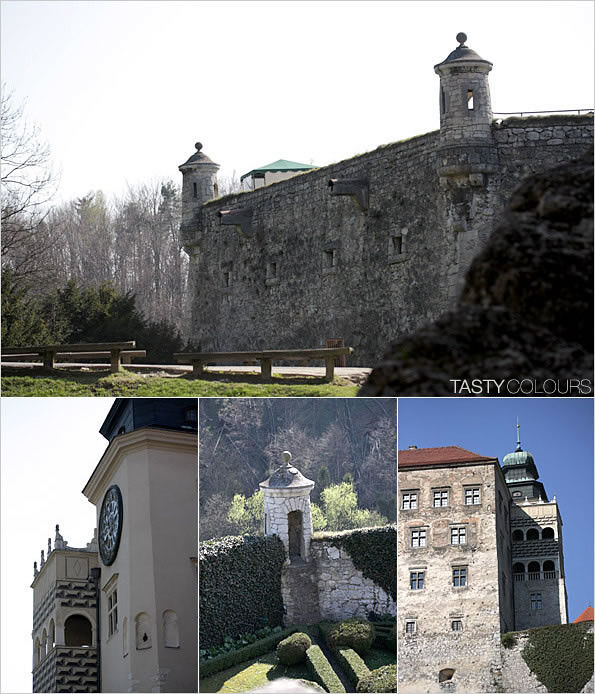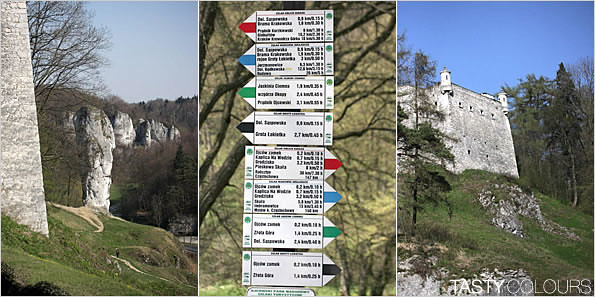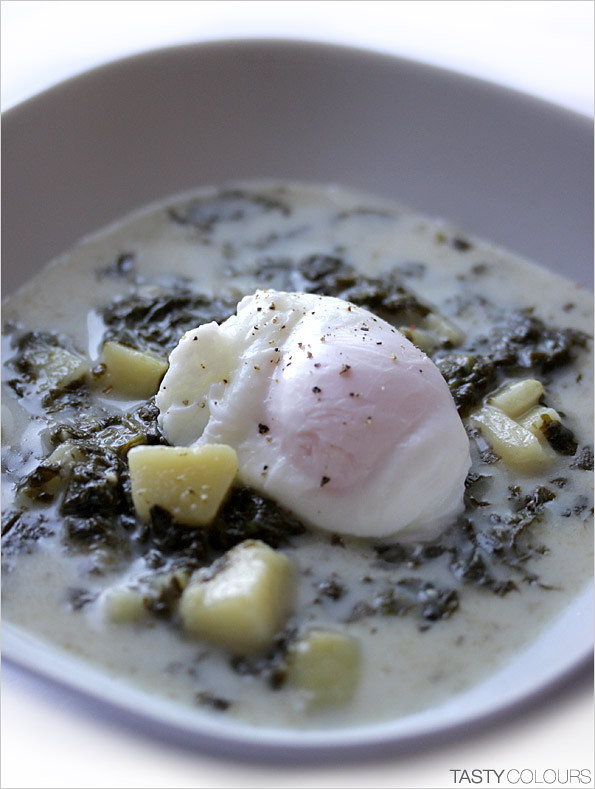Ouloulou, it’s been more than three months already since my last post. What a shame. Let me explain everything, if anybody still checks my blog after such a long and embarrassing period of silence.
Here’s the reason: we moved to Krakow at the end of February. We had (and we still have) to organize our life and jobs here.
I should have warned you. But I did not, because I was convinced that I would come back to blogging right after my arrival here. That was a big, big mistake – the daily duties of my new life did not allow for that. Further, I was a bit discouraged. You know, for the last few years I was visiting my country very often, but I was only a visitor here – the center of my life was in Paris, where I developed my passion for the culinary world. On the other hand, I had an idealized image of my home country and my hometown, which probably is a quite common feeling when you are an immigrant. Now, I am not an immigrant anymore, I am back here and I have to face Polish realities. I am a resident, and my husband is an immigrant. You know, it is difficult for my Parisian husband to adapt to Kraków. He misses Paris; he misses its food: crispy Parisian baguettes, he cries for croissants or pain au chocolat for breakfast (you can get them here, too; but they are of an awful quality), côte d’agneau from Mr. Bajon, chocolate macarons from Ladurée and so on. I do not have any solution: I will have to open a home bakery, otherwise our life will become unbearable.
To change our mind a bit, I decided that we would spend a couple of days (that was at the end of April) with some friends in Ojców (although my husband wanted to stay home), a peaceful and green environment (you know, allegedly when you look at green trees and grass you are supposed to relax) – the village which is at the center of the Ojców National Park, which is the smallest in Poland (21 km2), located 25 km north of Kraków. The park is famous for its castles, caves (around 400 of them), rocks, limestone cliffs and two picturesque river valleys. Ok, let’s say that in comparison with hoodoos that one can find in Bryce Canyon in Utah, it is not so spectacular. One can always complain. However, we’re in Poland, not in Utah and our little rock area is not so bad. Evenings at the bottom of the rock valley resemble the ambience of the old Peter Weir’s movie “Picnic at Hanging Rock”. And in the village of Ojców, unlike Bryce Canyon or Zion Park, there is a ruined Gothic castle, located on a hill (a few years ago, some friends of mine organized a wedding party there). A few kilometers away, one can also visit another castle called “Pieskowa Skała”. Both castles were part of a late-medieval natural system of defense in southwestern Poland (Trail of the Eagles' Nests), constructed under the order of Kazimierz the Great, the King of Poland in the 14th century.
So, we spent a couple of days there, taking walks, sitting on freshly grown spring and juicy grass, checking out the neighborhood, sipping wine or beer, eating outside, chatting with friends, playing with kids. Simple life, and a substitute for countryside holidays when I was a kid. Eating simple food (the most extravagant one being sausages fried over a bonfire). Finally my husband admitted that it had been a good idea to come here.
The Ojców village is tiny (around 80 households, but only around 20 families live there all year round, for example, my old friend Wojtek, who is a wine expert and promotes vineyards – yes, yes, there are some vineyards in Poland and you will find out in some coming posts). Thanks to its location in the middle of the National Park, the village is subject to many legal restrictions, like, for example, the prohibition to sell real estate and construct new houses. However, we could notice a few new and quite ugly constructions, so I am not sure who delivers building permits. People go there to climb rocks, take bicycle tours and practice Nordic walking.
We had lunch in the only restaurant that exists there, which actually rather is a bistro. In the contrary to the French provinces where one can find decent food in tiny villages, meals served in this Ojców bistro were not good; Pascal ordered potato pancakes which apparently were made from some artificial powder; chewy and gummy, with no taste; the sauce accompanying them was a good friend of the Knorr corporation; I ordered some pierogi, which appeared to be previously frozen, and which most likely were not made on site. How come that in such a beautiful place, visited by numerous tourists who come to spend some good time with mother nature, one cannot try good, seasonal products and regional meals ? Do they think people are stupid?
Well, so it’s already the beginning of June, and we are in the asparagus season. This year, however, I will start the season with a classical, rustic soup. Nothing special. Forgotten vegetables and a soup which was one of my culinary nightmares when I was a kid. I mean I will start from sorrel.
Do you like sorrel? Sorrel, collected here either as a wild growing plant or as a cultivated one, was more popular in Poland when I was little. Nowadays one can find it on food markets, but it is not so common anymore – as one of the farmers told me, people do not buy it so often, so there’s no interest to bother, it means to collect it wild or to plant it. The most common preparation using sorrel in Poland is “sorrel soup”. Or, rather, I will admit that I do not know of any other Polish dish with sorrel (which does not mean that they are none). This rustic style and not-so-good-looking soup (as you know, the color of sorrel, once cooked, changes into something that looks like rust) is served with hard-boiled eggs. Today, I propose you to serve it with poached eggs, which brings a little change to a classical dish.
Sorrel soup with hard boiled eggs was very often served in my school cantina (of course, when in season). I never liked it, as it was always too thick, as too much flour was added to it and it tasted awful. However, now, I like sorrel for its sour taste – as I like sour taste in general. Sauteed with garlic, and placed into a light broth it may actually taste quite good!
Sorrel soup
Serves 4
Ingredients
1 liter chicken or beef broth (you can use vegetarian broth, too)
300-400 g sorrel leaves, washed, stalks removed
2 big garlic cloves, peeled and finely chopped
2 tablespoons butter
6 baby potatoes, peeled, washed and cut into quarters
4 eggs
100 ml sour cream (optional)
2 tablespoons chives, finely chopped
Salt
Pepper
1 tablespoon lemon juice (optional)
1 tablespoon white vinegar
1. In a hot frying pan, melt butter, add garlic and fry for 1-2 minutes. Add sorrel and braise for about 5 minutes, until they lose their natural green color.
2. In a saucepan, bring the chicken stock to a boil. Add potatoes and cook for about 10-15 minutes or until soft.
3. Add sorrel with garlic and their own juices. Mix well. Remove the soup from the heat. Add cream, tempering it previously, mix well but do not boil again. Salt and pepper for taste. If necessary, add a bit of lemon juice.
4. In the meantime, prepare poached eggs. In a flat, but large saucepan, bring water to a boil. Add some vinegar. Break the eggs and put each of them delicately into boiling water. Cook over minimum heat for about 3-4 minutes and then remove delicately with a spatula. Remove the excess of water by placing each egg on a paper towel.
5. Pour the soup into plates. Place delicately one poached egg in each plate and sprinkle with chives.
Polish version - wersja polska przepisu
Polish version - wersja polska przepisu
Przepraszam Was za długie milczenie. Tak jak już wyjaśniłam w wersji angielskiej oraz na mojej stronie na Facebooku, trzy miesiące temu przeprowadziliśmy się do Polski. Nie planowałam przerwy w blogowaniu i dlatego też nie uprzedziłam o tej przeprowadzce. Jednakże sprawy i bieżące problemy związane z tą przeprowadzką oraz zderzenie z polską rzeczywistością nieco (a właściwie, dość sporo) skorygowały moje założenia. Dopadła mnie niemoc twórcza, eksperymenty w kuchni zarzuciłam, zaś aparat fotograficzny pokrył się warstwą kurzu.
Dwa tygodnie temu spędziłam kilka dni w niemieckiej Bawarii – głównie w związku ze sprawami zawodowymi. Miałam jednak parę dni dla siebie i udało mi się nawet wypić trochę (hmmm...) bawarskiego piwa, odwiedzić parę monachijskich przybytków kulinarnych, w tym świetny Viktualienmarkt. Aparat poszedł w ruch, ale o tym w kolejnych postach, które już od tej pory będą się pojawiać regularnie (hmmm, miejmy nadzieję...). A na razie poczciwa i codzienna zupa szczawiowa, brunatny postrach przedszkolnych i szkolnych stołówek, który dzisiaj serwuję z jajkiem w koszulce. Lubicie szczaw ?
Zupa szczawiowa
Składniki (4 osoby)
1 l wywaru z kurczaka lub wołowiny (można użyć również wywaru jarzynowego)
300-400 g szczawiu, umytego i ewentualnie obranego z twardszych łodyg
2 duże ząbki czosnku, obrane i drobno posiekane
6 młodych ziemniaków, obranych i pokrojonych w ćwiartki
4 jajka
100 ml śmietany (opcjonalnie)
2 łyżki posiekanego szczypiorku
Sól
Pieprz
1 łyżka soku z cytryny (opcjonalnie)
1 łyżka octu
Na rozgrzanej patelni rozpuścić masło, dodać czosnek i zezłocić przez około minutę lub dwie uważając, aby się nie przypalił. Dodać szczaw i dusić około 5 minut, aż straci naturalny zielony kolor.
Wywar zagotować w garnku, dodać ziemniaki i gotować do miękkości, to jest około 10 – 15 minut.
Do zupy dodać szczaw z czosnkiem oraz szczawiowym sokiem, który ewentualnie powstanie podczas duszenia. Zamieszać i zdjąć z ognia. Dodać śmietanę, uprzednio ją hartując w odrobinie zupy i całość zamieszać. Doprawić solą oraz pieprzem. Jeżeli zupa jest mało kwaśna, można dodać sok z cytryny.
W międzyczasie przygotować jajka w koszulkach: w niezbyt głębokim, lecz szerokim rondlu zagotować wodę i dodać ocet. Rozbić jajka i delikatnie umieścić każde w rondlu uważając, aby nie naruszyć struktury białka i żółtka (ja zawsze wbijam każde jajko do osobnego, małego platikowego pojemniczka, ewentualnie do filiżanki, a następnie umieszczam je kolejno w rondlu, starając się nie naruszyć struktury). Gotować na minimalnym ogniu około 3-4 minut, a następnie wyjąć za pomocą łyżki cedzakowej lub szpatułki i osuszyć na ręczniku papierowym.
Zupę przelać do talerzy. W każdym umieścić jajko w koszulce i udekorować posiekanym szczypiorkiem.











9 comments:
So glad you are back! And that you are getting settled. This soup looks wonderful. I rarely use sorrel because I never know what to do with it, so this is perfect for me!
Missed you!
So glad that you're back. Transitioning is always so stressful!
This soup looks so delicious!
Wow, that's amazing, I just left a comment yesterday wondering what was happening with you...
great to see you back and blogging!
Moving is never fun - I'm going through one right now, so you have my sympathies...
Welcome to the blogosphere!
I'm SO glad you're back, Magdalena! I've missed you and your inspiring posts. :-)
I am very pleased that you've come back to blogging. :) Fingers crossed for you, I hope everything goes well for you and your family in Poland. :) I love sorrel, lovely soup.
A za mna chodzic taki szczawiowy sos do rybki... Ciesze sie, ze jestes z powrotem na blogu!
That poached egg really compliments this soup. Looks waaay better than a half of a hardboiled egg, the usual garnish for this dish.
Guys !!!
I deeply appreciate that you remembered about me after such a long period of silence. Really !
Thanks for visiting my blog and leaving encouraging comments.
Yes, transitioning was stressful, indeed. It was awful and I was exhausted.
It was not so much fun.
But now I can see a light in a tunnel :) and I am sending to all of you big kisses ...
I can relate; when I moved back to Lebanon for a few months it was hell getting adjusted and having family so close was actually very stressful. Your husband should look at the bright side. (Easier said than done); I would miss the baguettes and Ladurée; but hey, I think even Poilâne will ship!
Post a Comment